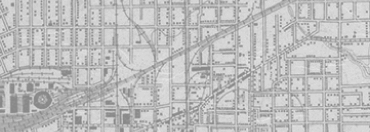


Back
Color slide transparency of the grassy knoll after shots were fired - Towner 3
One color slide transparency taken by Jim Towner on Friday, November 22, 1963, showing Elm Street, the triple underpass and the grassy knoll, approximately two minutes after the assassination. This image, known as Towner 3, is the third of four pictures Towner took in Dealey Plaza that day. Towner was standing on the south side of Elm Street, facing northwest. The image shows the triple underpass in the background and the grassy knoll on the right side of the road. Onlookers are running down the street, toward the top of the knoll and the place where the underpass meets the stockade fence above the knoll. The second of three motorcade buses is entering the triple underpass.This image was taken with a Yashica 44-LM twin-lens still camera (2015.009.0001), and is on 35mm 127 format Kodak film. The original cardboard slide mount has been removed, revealing the full image and a black border. The top and bottom edges are unevenly cut.
Color slide transparency of the grassy knoll after shots were fired - Towner 3
11/22/1963
Film
1 15/16 × 1 15/16 in. (4.9 × 4.9 cm)
Towner Collection/The Sixth Floor Museum at Dealey Plaza
2015.009.0004
This picture, taken about 45 seconds after Towner 2, shows eyewitnesses running up the grassy knoll and to the triple underpass. Police motorcycle officer Clyde Haygood, who had been escorting the motorcade, noticed the onlookers running and parked his bike on the street to investigate. He later told the Warren Commission that witnesses pointed to the underpass. He followed some of them and more witnesses followed him. Upon arrival at the underpass, Haygood searched the area but found nothing other than railroad employees who had been watching the motorcade.The man walking toward the underpass on the sidewalk and wearing a light-colored jacket and dark pants is known to researchers as The Dark-Complected Man (DCM) or The Cuban. He never came forward and his identity remains unknown. He is thought by some to be using a walkie-talkie radio to communicate with co-conspirators. Others believe the shiny rectangular device on his belt is nothing more than an ordinary radio.The men on the top of the triple underpass - which was and still is railroad property - were observed by two Dallas police officers during the time the motorcade was in Dealey Plaza and all were identified as railroad employees to Union Terminal railroad signal supervisor S.M. Holland or one of the officers before the motorcade arrived.The man wearing the red jacket and seated on the steps leading up the knoll is Dealey Plaza groundskeeper Emmet Hudson, who told the Warren Commission he heard three shots coming from above and slightly behind him to his left, indicating the Texas School Book Depository.The other three men on the steps remain unidentified, as does the man in light clothing apparently looking into the parking lot area where a small crowd had gathered.Inside the pergola at the right edge of the picture are presumably, from left to right, Beatrice Hester (Abraham Zapruder's payroll clerk), Zapruder and one other person. Several other films and photos show Hester, her husband Charles, Zapruder and Zapruder's receptionist, Marilyn Sitzman - who wore a light tan suit that day - all gathered inside the west end of the pergola after the shooting. Hester's legs, dark skirt and the shape of her hair can be discerned behind and above Zapruder's right shoulder. The indistinct shapes at the extreme right edge are likely either Sitzman or Charles Hester.Zapruder, who appeared on WFAA-TV and the ABC network just two hours later, was wearing a dark suit, white shirt, tie and hat - all of which are seen in Towner 3. This is the last known picture of Abraham Zapruder in Dealey Plaza, although he remained there for nearly ten more minutes. - Gary Mack, Curator
Color slide transparency of the grassy knoll after shots were fired - Towner 3
One color slide transparency taken by Jim Towner on Friday, November 22, 1963, showing Elm Street, the triple underpass and the grassy knoll, approximately two minutes after the assassination. This image, known as Towner 3, is the third of four pictures Towner took in Dealey Plaza that day. Towner was standing on the south side of Elm Street, facing northwest. The image shows the triple underpass in the background and the grassy knoll on the right side of the road. Onlookers are running down the street, toward the top of the knoll and the place where the underpass meets the stockade fence above the knoll. The second of three motorcade buses is entering the triple underpass.This image was taken with a Yashica 44-LM twin-lens still camera (2015.009.0001), and is on 35mm 127 format Kodak film. The original cardboard slide mount has been removed, revealing the full image and a black border. The top and bottom edges are unevenly cut.
Color slide transparency of the grassy knoll after shots were fired - Towner 3
11/22/1963
Photographs
Cameras
Grassy knoll
Eyewitnesses
Dealey Plaza
Elm Street
Triple underpass
Towner, Jim
Kodak
Dallas
Film
1 15/16 × 1 15/16 in. (4.9 × 4.9 cm)
Towner Collection/The Sixth Floor Museum at Dealey Plaza
2015.009.0004
This picture, taken about 45 seconds after Towner 2, shows eyewitnesses running up the grassy knoll and to the triple underpass. Police motorcycle officer Clyde Haygood, who had been escorting the motorcade, noticed the onlookers running and parked his bike on the street to investigate. He later told the Warren Commission that witnesses pointed to the underpass. He followed some of them and more witnesses followed him. Upon arrival at the underpass, Haygood searched the area but found nothing other than railroad employees who had been watching the motorcade.The man walking toward the underpass on the sidewalk and wearing a light-colored jacket and dark pants is known to researchers as The Dark-Complected Man (DCM) or The Cuban. He never came forward and his identity remains unknown. He is thought by some to be using a walkie-talkie radio to communicate with co-conspirators. Others believe the shiny rectangular device on his belt is nothing more than an ordinary radio.The men on the top of the triple underpass - which was and still is railroad property - were observed by two Dallas police officers during the time the motorcade was in Dealey Plaza and all were identified as railroad employees to Union Terminal railroad signal supervisor S.M. Holland or one of the officers before the motorcade arrived.The man wearing the red jacket and seated on the steps leading up the knoll is Dealey Plaza groundskeeper Emmet Hudson, who told the Warren Commission he heard three shots coming from above and slightly behind him to his left, indicating the Texas School Book Depository.The other three men on the steps remain unidentified, as does the man in light clothing apparently looking into the parking lot area where a small crowd had gathered.Inside the pergola at the right edge of the picture are presumably, from left to right, Beatrice Hester (Abraham Zapruder's payroll clerk), Zapruder and one other person. Several other films and photos show Hester, her husband Charles, Zapruder and Zapruder's receptionist, Marilyn Sitzman - who wore a light tan suit that day - all gathered inside the west end of the pergola after the shooting. Hester's legs, dark skirt and the shape of her hair can be discerned behind and above Zapruder's right shoulder. The indistinct shapes at the extreme right edge are likely either Sitzman or Charles Hester.Zapruder, who appeared on WFAA-TV and the ABC network just two hours later, was wearing a dark suit, white shirt, tie and hat - all of which are seen in Towner 3. This is the last known picture of Abraham Zapruder in Dealey Plaza, although he remained there for nearly ten more minutes. - Gary Mack, Curator









